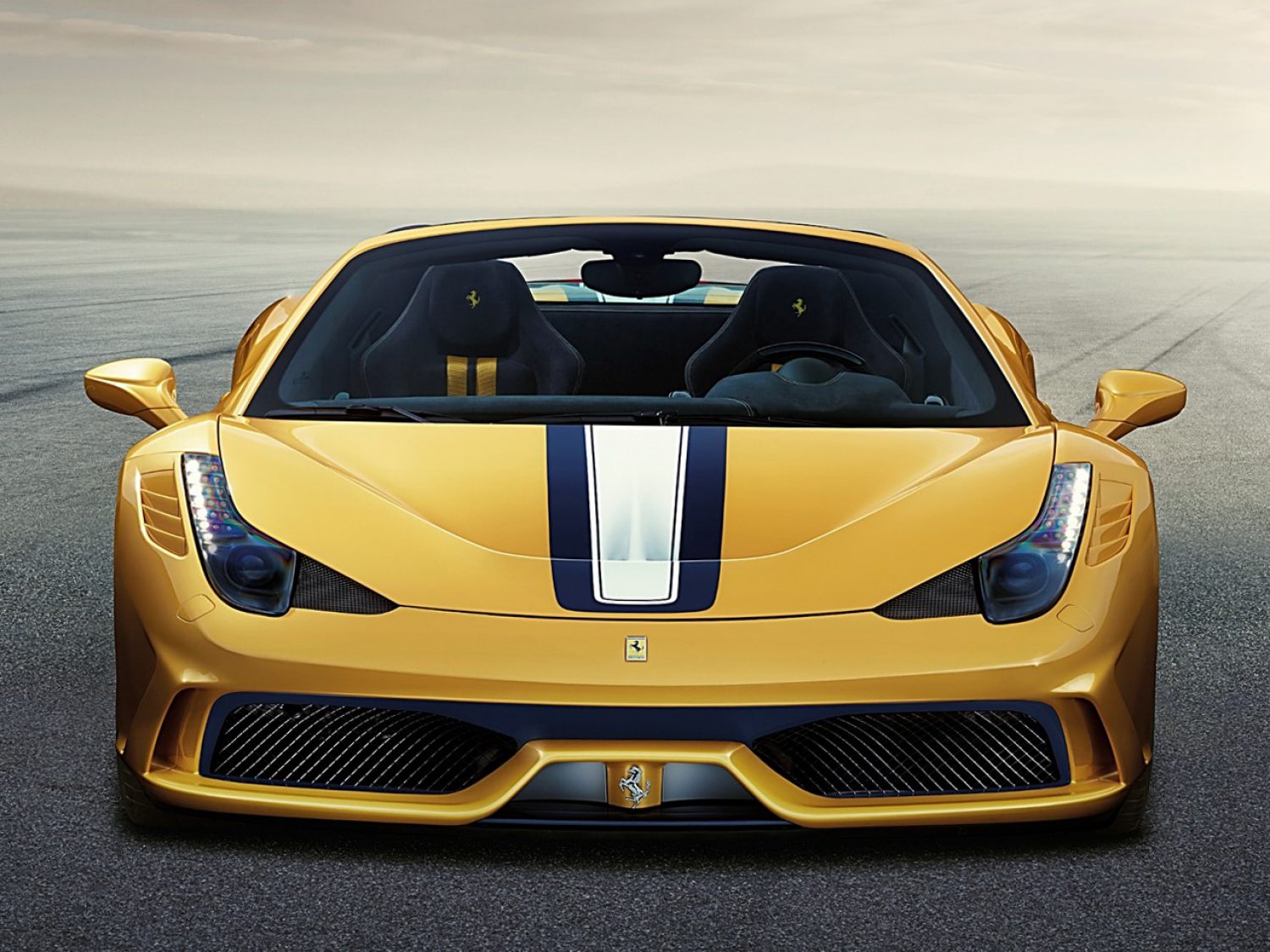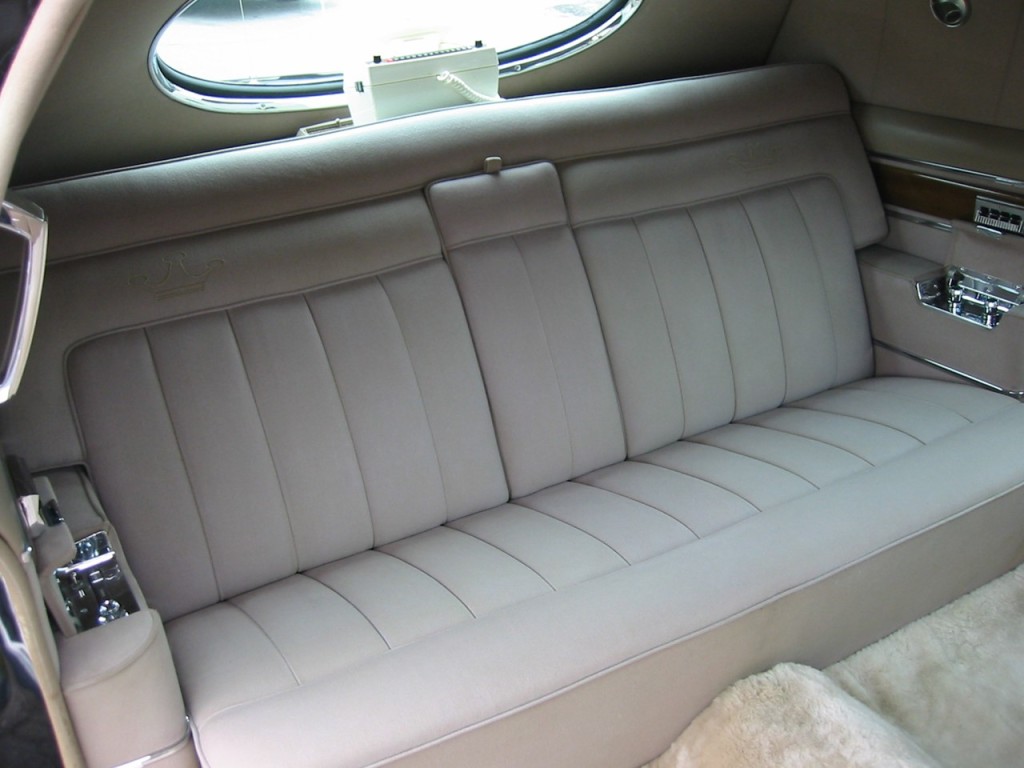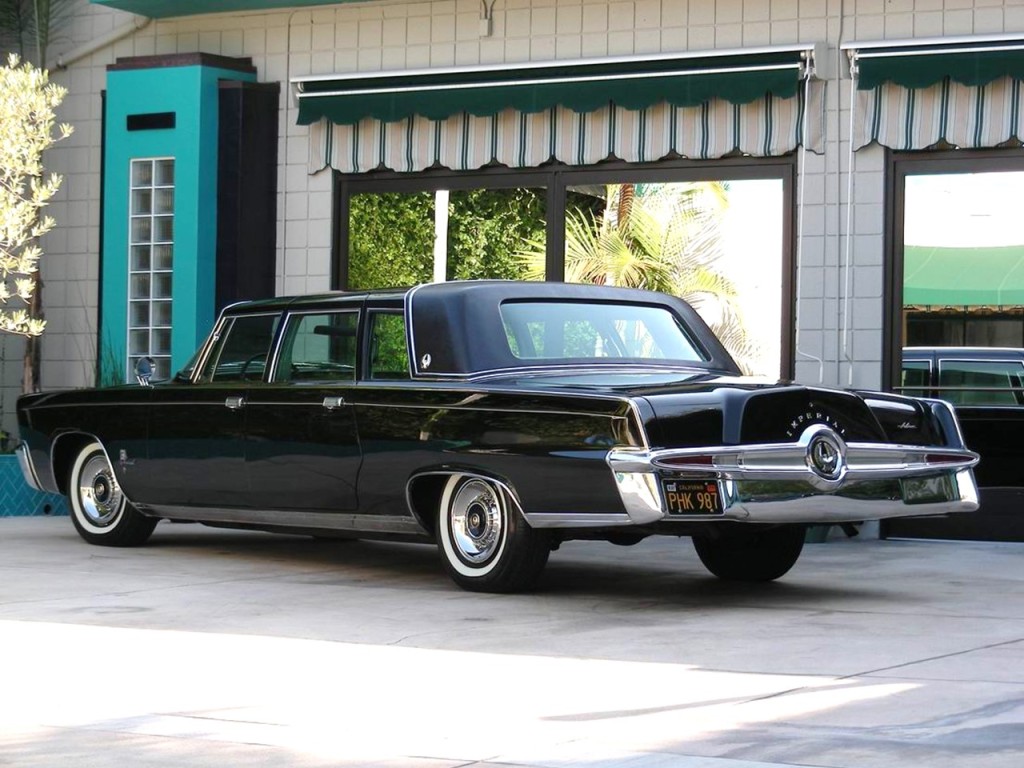Crown Jewel: 1964 Ghia Landau Crown Imperial Limousine
The epitome of limousine luxury…
A Ghia Landau Crown Imperial is an ultra-rare collector’s dream. Ghia, one of the foremost automobile coachbuilders in the world was commissioned to build these opulent vehicles. There were only 10 built for the all-new body style in 1964. An Imperial is luxurious as it is…add the distinction of Ghia luxury refinement and it became even more provocative.
Only 132 of these magnificent hand-crafted limousines were built from 1957 until 1965 when production ceased. These are highly sought by connoisseurs world-wide. They are highly bespoke works of automotive art that offer an extraordinary degree of creature comforts.
1965 Ghia Landau Crown Imperial Limousine one of 10 built
The Crown Imperial Limousine stands alone in a world where individuality has virtually disappeared…unlike today’s mass-production nightmares that are made twice as fast and equally as horrid. The Crown Imperial is the ultimate expression of dynamism and luxury. The formidable Imperial is a legend of automotive superiority…a Crown Imperial Limousine is motoring in the grand manner. These elite motorcars are unsurpassed in dignity, comfort, and elegance. They are the most aristocratic of all chauffeured American automobiles –
A custom-crafted Ghia Landau Crown Imperial Limousine is the absolute pinnacle of limousine luxury and distinction. Ghia designed and hand-built highly bespoke automobiles that are valuable and will become priceless collectibles. Giacinto Ghia and Gariglio established Carrozzeria Ghia & Gariglio of Turin, Italy in 1916. Ghia Limousines are some of the rarest and most collectible automobiles in existence. The 1964 Crown Imperial Limousine is among the world’s last coachbuilt masterpieces. Production by Ghia has always been kept at a highly restricted pace which gave the company’s products even greater exclusivity and supremacy.
1955 Crown Imperial 8 passenger sedan
1956 Imperial Limousine
In the early days of Virgil Exner’s “Forward Look,” 1955 and 1956 models were way too expensive to build and make a profit. The tooling for a new limousine cost well over $3,300,000. Due to relatively low sales of less than 400 vehicles, it was not cost-effective to continue without exceeding the company budget. The corporate bean counters decided outsourcing was the most cost efficient manner to expedite the limousines in order to lower factory burden and make a profit.
The search began in the USA but was fruitless. Chrysler consulted with Carrozzeria Ghia and their association resulted in a positive collaboration as it had previously. This isn’t the first venture between the two. Wages for skilled labor was much lower in Italy than here in the US. Ghia and Chrysler came to an agreement which kept actual costs affordable to Chrysler. The contractual agreement was that Ghia would do all of the custom conversion work and deliver the cars to the USA ready to drive.
The production of these magnificent automobiles was expensive, even farming out the work to Ghia. There were issues from time to time which added to the financial burden. The first Ghia limos required larger tires that had to be retrofitted. All electrical components and wiring had to be checked and repaired when the vehicles were shipped to the USA because these systems were too complicated for the Italian workers at the time. And of course there were the tariffs and other administrative protocol to manage.
The designers at Chrysler went to work on the new project. The 1957 Imperial was a suitable base, and it was newly designed. It was also the most popular Imperial in the history of the brand outselling each and every subsequent model year. The wheelbase was decided to be 149.5” with an overall length of 244.7” and a height of 58.5” which proved to be feasible.
A full-size mock-up was created using the extra rigid convertible chassis with reinforced “X” frame. An Imperial hardtop coupe bodyshell on the 129” wheelbase was used. The interior was stripped and packed with parts for the conversion. Four sedan doors, window glass, a fully wired dash, double air conditioning unit, leather for upholstery, carpet, and other miscellaneous parts were coordinated so that nothing was lost during the transport to Italy.
The hand-crafting included sectioning the body and frame to lengthen and reinforce the platform. Ghia was so fastidious with the welds that one would have to search really hard to see where the sections were added, they were as smooth as the single-piece frame it began as. The doors were built higher and a reconfigured roof structure to accommodate the revisions was necessary.
All of the custom hand-crafting was expedited by the artisans at Ghia without body-stamping dies or an assembly line…completely oblivious to the fact of how many man hours were spent. It could take up to and including 17 hours alone just to adjust the doors and fenders for the all-important shut lines to within 1/6” tolerances. This type of dedication would have not existed without extreme remuneration to workers in this country.
Conversions of this magnitude require diligence, tenacity, and an extreme desire to be the best in the industry. Aside from the hours upon end revising structural modifications, the final finish is contingent upon what’s underneath the paint. After all the joints are filled, the body is coated with 165 lbs. of solder. It was then rinsed in dilute acid to clean the surface in preparation for the zinc chromate primer. Special highlighting primers augment flaws and imperfections that need to be corrected.
After all surfaces are properly prepared, several coats of lacquer are applied and hand-polished between each coat to build the shine’s depth. Now here’s a step that is protocol for custom coach crafters which has been completely overlooked and forgotten in today’s mass-produced, I need it yesterday world. There is an application of a sepia and water mixture which gives the finish a diamond-hard, mirror-like reflection. The elegant limousines were available in black, brown, dark green, and dark blue. The total transformation took around 30 days.
In the limousine world, it’s the interior and its amenities that make the first impression. The 1964 Ghia Landau Crown Imperial Limousine exhibited extraordinary good taste. Unlike a “stretch” limousine which is merely a lengthened standard luxury sedan; the Crown Imperial is built specifically as a limousine. From the cowl rearward everything is refined to reflect the quality of a custom crafted automobile.
The seat frames for both compartments are custom-made by Ghia specifically crafted for the Landau Crown Imperial Limousine. The driver’s compartment is upholstered in black leather with a unique sew-style that conceals the stitching. The driver’s seat is wider and graciously contoured. The passenger compartment is luxuriously cushioned and covered in an elegant broad cloth, the stitching is also concealed. Even the framework on the auxiliary jump-seats is intricate.
Five interior color schemes were offered in grey or beige with opulent mouton carpets. The interior accents are dyed to match the broadcloth upholstery for a dramatic monochromatic look. The carpeted floor mats are leather-bound with a fastening system underneath to keep them stationary. Creature comforts are designed to cosset its passengers in complete exclusivity. The passenger compartment has complete modification over the standard styling. Hardware is custom cast and richly chrome plated. The garnish moldings are ½” thick genuine richly grained hand-crafted walnut.
The passenger compartment has its own separate heating and air conditioning controls. The left rear armrest conceals the controls. The trunk houses the A/C evaporator. The unique heater is an under seat unit with chrome ducts at the base of the armrests. The right rear seat armrest houses the controls for the radio. Four-button chrome window switches are mounted on both side panels that operate windows, door locks, overhead lighting, and the power glass privacy partition. The rear doors are lockable from the outside and have different keys than the front doors.
The 1964 Ghia Landau Crown Imperial Limousine weighed 6,100 lbs. and had a base price of $18,500 USD. It rides a commanding 149.5” wheelbase, has the extreme-luxury length of 248.3” and is 80” in width. It is powered by the Chrysler RB-Series 413 CID Wedge-head 6.8 litre 16-valve naturally aspirated V8 engine. It produces 340 hp @ 4,600 rpm with 637 Nm of peak torque @ 2,800 rpm. The engine is mated to the Chrysler TorqueFlite automatic torque converter with 3-speed planetary gear set.
Special thanks to Conceptcarz
This four-window version is the rarest of all Crown Imperials
Notice the primitive telephone system…
1964 Ghia Landau Crown Imperial owned by Richard Rowlands
Here are the production totals from 1957 through 1965: 36 were built in 1957, 31 were built for 1958, 7 were built for 1959, 16 were built for 1960, 9 were built for 1961, there were none built for 1962, 13 were built for 1963, 10 were built for 1964, and 10 were built for the 1965 model year when Ghia production ceased for Chrysler. It is rumored the contract was precluded because Ghia had no experience with unibody construction. Imperials were built as body on frame construction from 1957 until 1966.
Ghia coachwork is the pinnacle of automotive design. The fastidious hand-crafting is evident in this luxury barouche. The Ghia Landau Crown Imperial Limousine is the last of the magnificent motorcars. Ghia coachcrafting could be compared to that of Mulliner Park Ward, James Young, or even Derham. Ghia escalates the incomparable Imperial to absolute superlative. Every square inch of the 1964 Ghia Landau Crown Imperial Limousine makes a bold statement. It’s mesmerizing like a siren…when one gets close enough to it, they are entranced by the opulence of its sheer beauty, combined with the exemplary fit and finish. This was the end of the grandest motoring era in automotive history…
“Smiling” for the camera is a 1960 Crown Imperial Limousine
Photos courtesy of the On-line Imperial Club
Any guy that grew up in the 1960s will remember the Black Beauty from the TV series “The Green Hornet” starring Van Williams as Britt Reid and Bruce Lee as the indomitable Kato. Dean Jeffries, custom car designer and builder was commissioned to build the famous Black Beauty. It began as a 1966 Imperial Crown hardtop sedan. Jeffries built two cars one of which resides in the Petersen Museum Collection purchased for over $192,000 in December of 2003.
The Black Beauty has fully functional fighting gadgetry as there were no digital effects back in 1966. The cars are equipped with front and rear facing rocket banks, front and rear gas, oil, water, smoke cannons, rotating headlamps four of which are green and two in white, and rotating license plates. They also had a closed circuit TV and a rear seat cellular telephone (yes, back in 1966), brooms that swept away its tire tracks, and a host of other self-defense gadgetry. Now this is NotoriousLuxury!
Jay D’Angelo’s 1964 Imperial Convertible
Eric Ruud’s 1964 Imperial Coupe
Lupe Rodriguez’s 1964 Imperial Crown Coupe
Will there ever be more automotive masterpieces?
The 1964 Ghia Landau Crown Imperial Limousine



































































I purchased and sold both of the 1964 Ghia Limousines from Universal Studios in the late 70’s or early 80’s … Richard purchased one of them and I sold the other outside the Rose Bowl Car Swapmeet for the princely sum of $1500.00 (after painting it and doing some minor interior repair) that was an interesting story… One thing that sticks in my mind was that the front seat was not adjustable and too close to the steering wheel… with no tilt/telescope adjustments… Ken – Van Nut Auto Wrecking
$1500.00? I wish I had known about those. I would have purchased both of them. Put those cars in “mothballs” and they would have appreciated like mad. Every collector car has “its” time…like a fine Chateau Lafite Rothschild. There will never be automobiles like that again. They were history and you disposed of them! let me know if you run across a nice 1970 Cadillac DeVille convertible. I should never had sold mine….
As beautiful as it is (I owned one for many years) this is not the Landau model. The Landau did not have the rear quarter windows and was padded all the way to the back of the door.
Don, I asked a friend of my grand pa and he said the model you are speaking of is a rare “Four-window with blind quarter window option” but they were all considered “Landau” because of the sliver of vinyl roof as he called it.
Regardless, they are lovely automobiles deserving of their place in automotive history. I have tons of things to post for these old cars. I am almost back to normal. I have had a series of death in my family that’s knocked the sand out of me. I lost a sister and my father this year alone.
Yes, I understand what the landau was as I run the Packard / IMPERIAL page which has a roster of the Ghia-Imperials since I owned one for many decades. It was the caption for the 1964 6-window style identical to mine that indicated it was a landau which was what prompted my note. My father died unexpectedly last week so I know how difficult it can be.
Do you have any photos or information regarding Packard limousines? Do you have photos and specs for the Imperial Ghia models? I’d love to update this article with the latest information available for both Town and Landau models.
Hello Don! I am just going by what’s on the website. You have to take this up with the car’s owner. This may have been restored, I’m not sure. I just got permission to use the photos and history information. This is not one of my collection.
Greg
No, they were not all considered landaus so I’m not sure where your friend’s grandfather got that. It is simply not true. The landau name in the brochure is only for the 4-window type and has nothing to do with the leather padded top on the 6-window style. The landau style was also known as “formal” and applied to cars that did not have the rear quarter windows whether they were limousines (with partition) or long wheelbase sedans (no partition) and the Ghia-Imperials 9as they are properly called) were available either way although I know of none that were ordered without the partition..
Hello Don! I asked another old timer and he said there were two styles to the Ghia limos, the Town and the rare 4-window Landau model with the latter having a circular rear window treatment. This article was written back in 2017, I’ll have to search my archives to see who sent the stats in for these cars.
Another Imperial aficionado stated the fact these cars were updated by their owners when they were in service and they were restored to the owner’s requisites. Grilles and bumpers along with the padded roof covering could be swapped out.
Regardless, these automobiles are a thing of beauty and the last of an extremely impressive era in luxury motoring that the world will never get to savor again with the truck-like SUV taking over the roadways.
I think the 1964, 65 and 66 Imperials are the most beautiful cars ever made. The exterior styling is magnificent, beautiful and elegant. Every detail is unique and exquisitely designed to work with every part of the car. From its headlights under glass to it’s pointed taillights embedded into the rear bumper and the squared off shape of the trunk lid gives these Imperials such an elegant look from front to rear. It’s been said these model years resemble the 1960s Lincoln Continentals, and they do, however when you look closely you can see how they capture the strong corporate look that’s undeniably Chrysler. For example, the way that all Chryslers from the 60s headlights tend to look up at you with a shy and innocent character, that’s somehow cute and confident at the same time. I had a 66 silver with silver cloth and black leather interior 4 door hardtop Crown that I loved. 1966 was the first year for the iconic Chrysler 440 cubic inch engine that made the 66 Imperials as powerful as they are gorgeous. It was always comfortable and fun to drive.